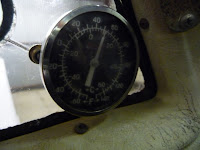[ gauge face down w/ fairing ] [gauge face]
[Scott gauge face][Scott gauge stem]
[Questair inside][Questair outside]








The Questair OAT is a digital gauge intended to replace the aging stem-style gauges that have a sensor that sticks out of a hole either in the windshield or pilot's window. I have a Scott gauge and it has clouded over and has also caused cracks in my pilot-side window so I looked into OAT alternatives and decided to go with the Questair. Additionally, the stem sticking out is large and detracts from the smooth lines of my plane. I doubt removal of it will have any effect on my airspeed--heck, my biggest problem is slowing her down!
One of the issues posted on a number of forums is the way Questair operates. One guy opined that:
The older gentleman who sells them is his own worst enemy from a marketing point of view, since he has no website, no email address and I have never successfully had him answer the phone. You have two options for ordering, either leaving a voicemail or sending a fax with your shipping address and credit card information, but he does return calls. He goes on vacation from time to time, and if you order while he's on vacation, it sits until he gets back.
I was visiting with my daughter in Florida when I called Questair to ask about the device and to place my order. I got the voicemail and left my name and number. Later, I discovered that my phone had a voicemail and it was Fred Kantor, owner of Questair Inc. He left a message and that was the last time I ever heard from him. I called back numerous times, left messages, etc., but no response. Fred is apparently an internal medicine physician, so he is probably busy most of the time and does this digital OAT gauge thing on the side.
So, I FAX'd my order in and in less than a week I had my unit--see pictures above. I could immediately see why some guys have had issues (I am an engineer after all). It is somewhat cheap plastic as aerospace equipment normally goes--but remember, if Mooney made this thing it would cost 1.5 AMU's instead of 0.08. The thermistor appears to be protected by a chromed or stainless bubble and the threaded shaft is a continuation of the case plastic. This latter part is the source of most of the problems others have had. If you tighten too much it is pretty clear to me that it will break, that much is obvious. The fairing that goes on the outside is of a tougher plastic, but the threads are very shallow. There is a foam washer the same ovoid shape as the fairing and what you want to do is use that washer to take the compression strain. The unknown is the thickness of the plastic window that you are mounting it to. There are extra washers and the key is to get the number of washers needed correct so that the shaft and fairing are not over tightened.
After installing it, I found it to be about a half degree off from the ATIS/AWOS temperature at the airport--so well within tolerance considering I was in my hangar. I like it because it replaces the problematic, difficult to read stem gauge and it automatically converts from degrees C to F for you with the push of a button. It also has an internal lamp, again accessed by a button. There are two batteries in the unit with a switch to select between the two--just like your fuel tanks in a Mooney. So, if the gauge fails to display, you turn the switch to give it a fresh battery. What's not to love?

